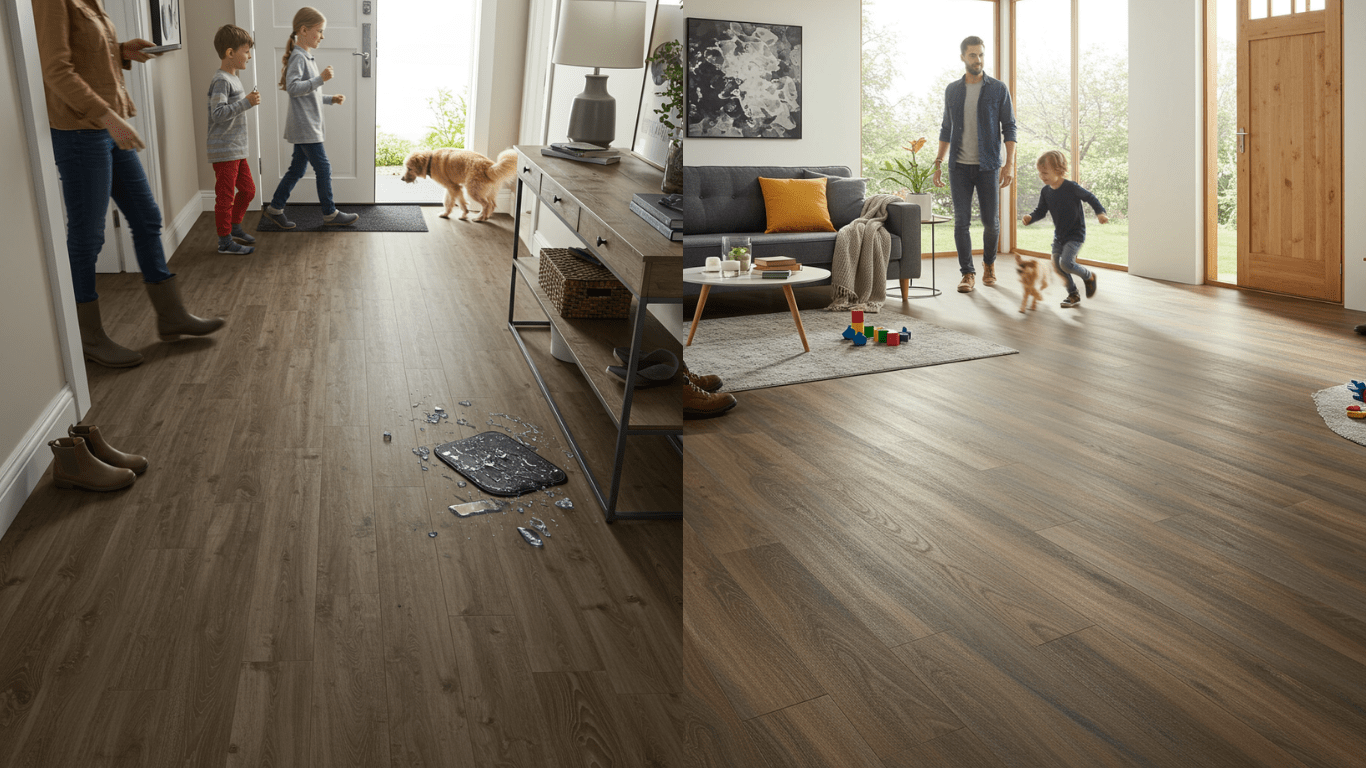Navigating the world of flooring can be overwhelming, especially when you need a surface that can withstand constant foot traffic without losing its charm. For years, vinyl flooring has gained a reputation as a top contender for high-traffic zones. Its unique blend of durability, style, and affordability makes it a go-to choice for homeowners and business owners alike.
Whether you’re outfitting a busy kitchen buzzing with family activity, a heavily used commercial space, or a bustling hallway, vinyl flooring balances function and aesthetics perfectly.
This guide will walk you through everything you need to know from why vinyl flooring thrives under pressure to tips on choosing, installing, and maintaining it. By the end, you’ll feel confident in making the smartest flooring choice for your space.
Vinyl Flooring for High-Traffic Areas
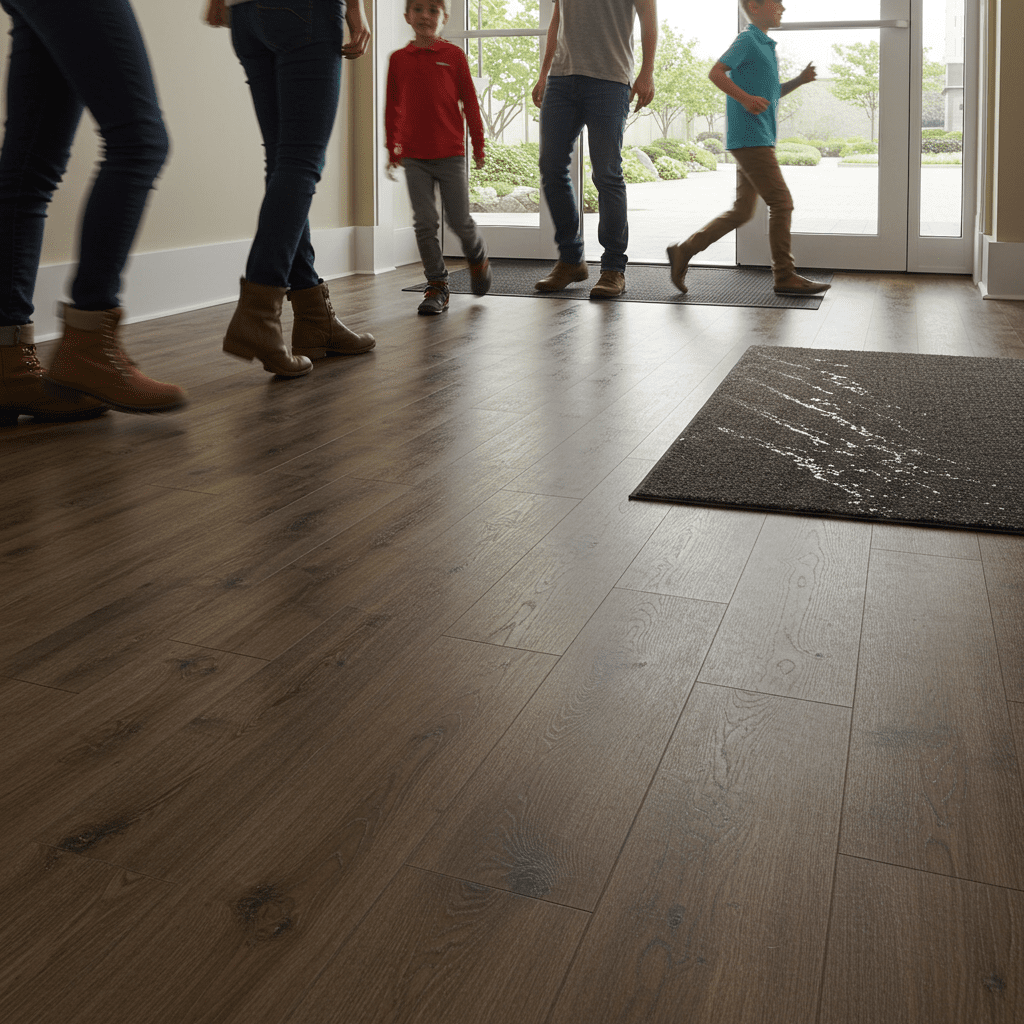
When it comes to high-traffic floor solutions, few materials can rival vinyl in durability, versatility, and aesthetics. Whether you’re dealing with bustling hallways, busy kitchens, or commercial spaces that see constant foot traffic, vinyl flooring is built to last.
Thanks to advancements in technology, today’s resilient flooring options can mimic the look of wood, stone, or ceramic tiles without compromising on floor durability ratings.
Vinyl flooring isn’t just about appearances. It’s engineered to handle wear and tear with features like protective floor coatings that guard against scratches, scuffs, and stains.
Additionally, its traffic-resistant surfaces provide long-lasting performance, making it a reliable choice for areas where durability is non-negotiable.
What Makes Vinyl Ideal for Busy Spaces
Durable vinyl flooring is a favorite for high traffic because it balances strength, affordability, and visual appeal like few other materials. Its multi-layer construction combines a rigid core with a wear layer that enhances durability while maintaining a comfortable feel underfoot.
Here are the key factors that make vinyl perfect for busy environments:
Wear-resistant vinyl: Thanks to its top wear layer, vinyl is highly resistant to scratches, dents, and stains—ideal for spaces with heavy foot traffic, pets, or busy families.
Moisture resistance: Unlike some materials, vinyl is water-resistant or even waterproof, depending on the type. This makes it an excellent choice for rooms like kitchens, bathrooms, and laundry areas.
Protective floor coating: Many vinyl options include additional coatings that guard against daily wear, ensuring the floor stays in great shape for years.
Low maintenance: With simple cleaning routines, vinyl floor maintenance is effortless, allowing you to enjoy your flooring without constant upkeep.
From residential to commercial setups, the combination of durability and style makes vinyl flooring a remarkable and practical choice for heavy-use spaces.
Related Read: Hybrid Flooring vs Vinyl Planks: Which Flooring Champion Wins Your Home?
Types of Vinyl Flooring Explained
Vinyl flooring offers a variety of formats, each catering to different needs and preferences. Whether you prioritize style, application, or ease of installation, understanding the various types of vinyl flooring will help you make the right decision for your high-traffic area.
Luxury Vinyl Plank (LVP)
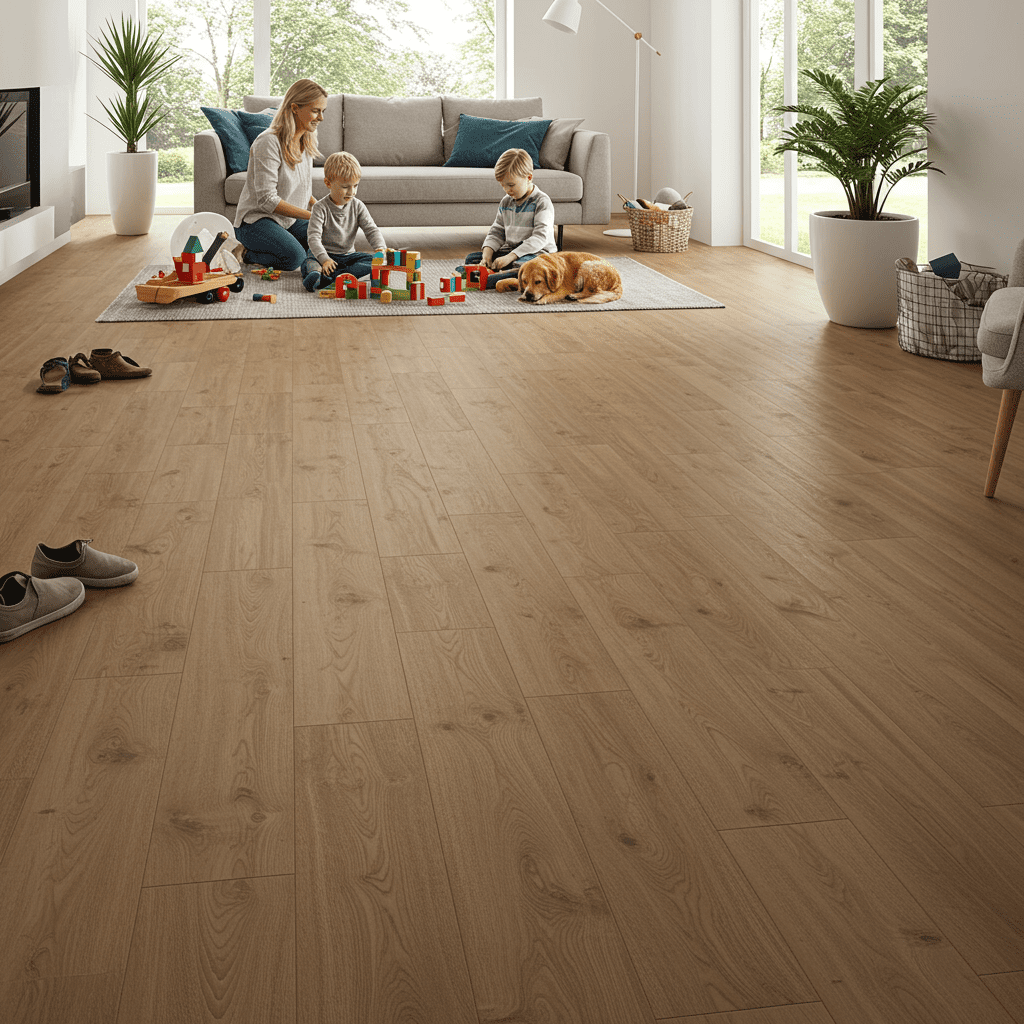
Luxury Vinyl Plank, or LVP, is one of the most popular choices for high-traffic areas. Designed to mimic the warmth and texture of hardwood, LVP has become synonymous with both style and functionality.
Its high-durability ratings and water-resistant features make it perfect for modern homes or busy commercial environments. Plus, it’s easy to install and replace individual planks if needed.
Luxury Vinyl Tile (LVT)
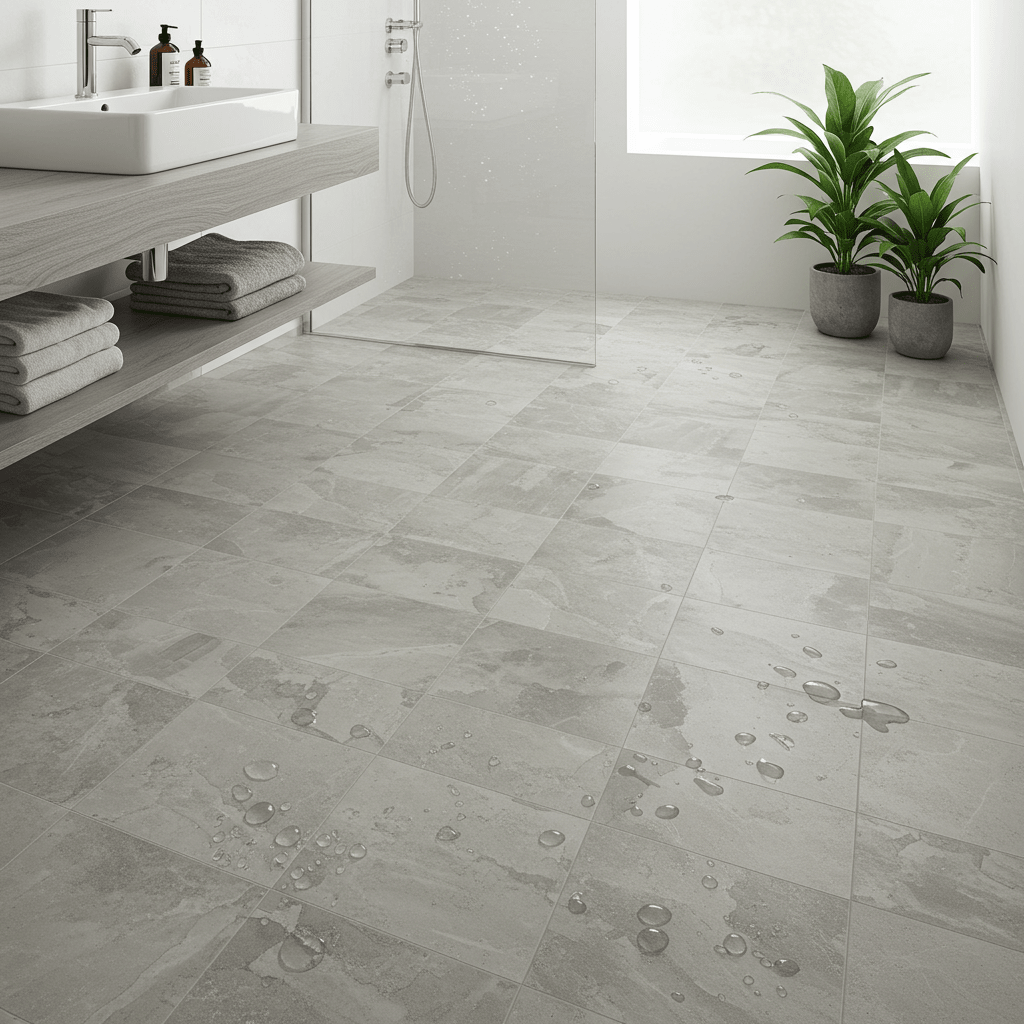
If you love the appearance of ceramic or stone but want something more resilient, Luxury Vinyl Tile (LVT) is an excellent option. Like LVP, it boasts durability and a realistic look but comes in tile format, making it ideal for precise patterns.
Additionally, LVT is often water-resistant and includes traffic-resistant surfaces, making it a go-to for both bathrooms and offices.
Sheet Vinyl
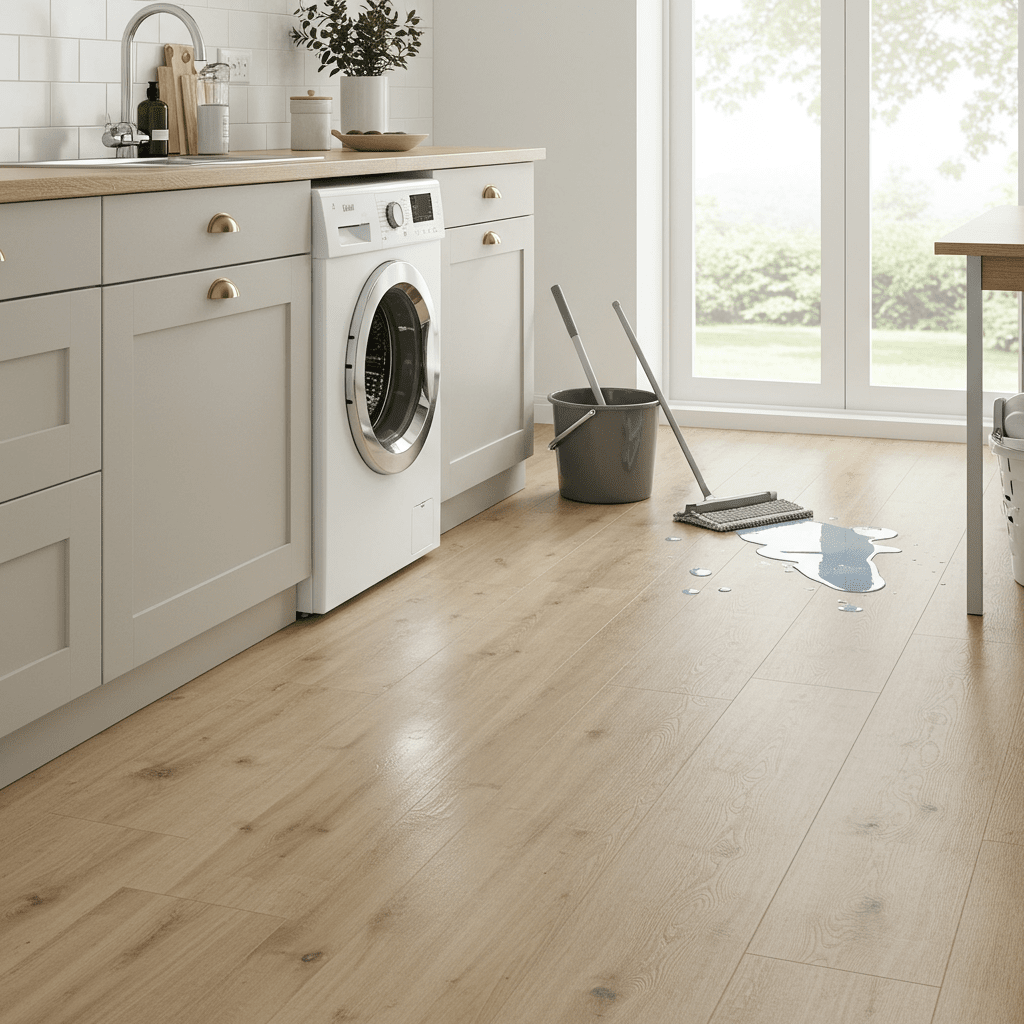
For those prioritizing affordability and seamless installation, sheet vinyl is a classic choice. This type of flooring comes as a large, continuous sheet, minimizing seams and offering excellent water resistance.
It’s especially useful in spaces where spills and moisture are common since the lack of seams prevents water from seeping through.
Related Topic: How To Get Water Stains Out Of Vinyl Flooring
Key Factors to Consider
When selecting durable vinyl flooring for high-traffic areas, there are several important factors to keep in mind. From the thickness of the wear layer to understanding how commercial vs. residential ratings differ, these aspects will help you choose a floor that balances form, function, and longevity.
Wear Layer Thickness
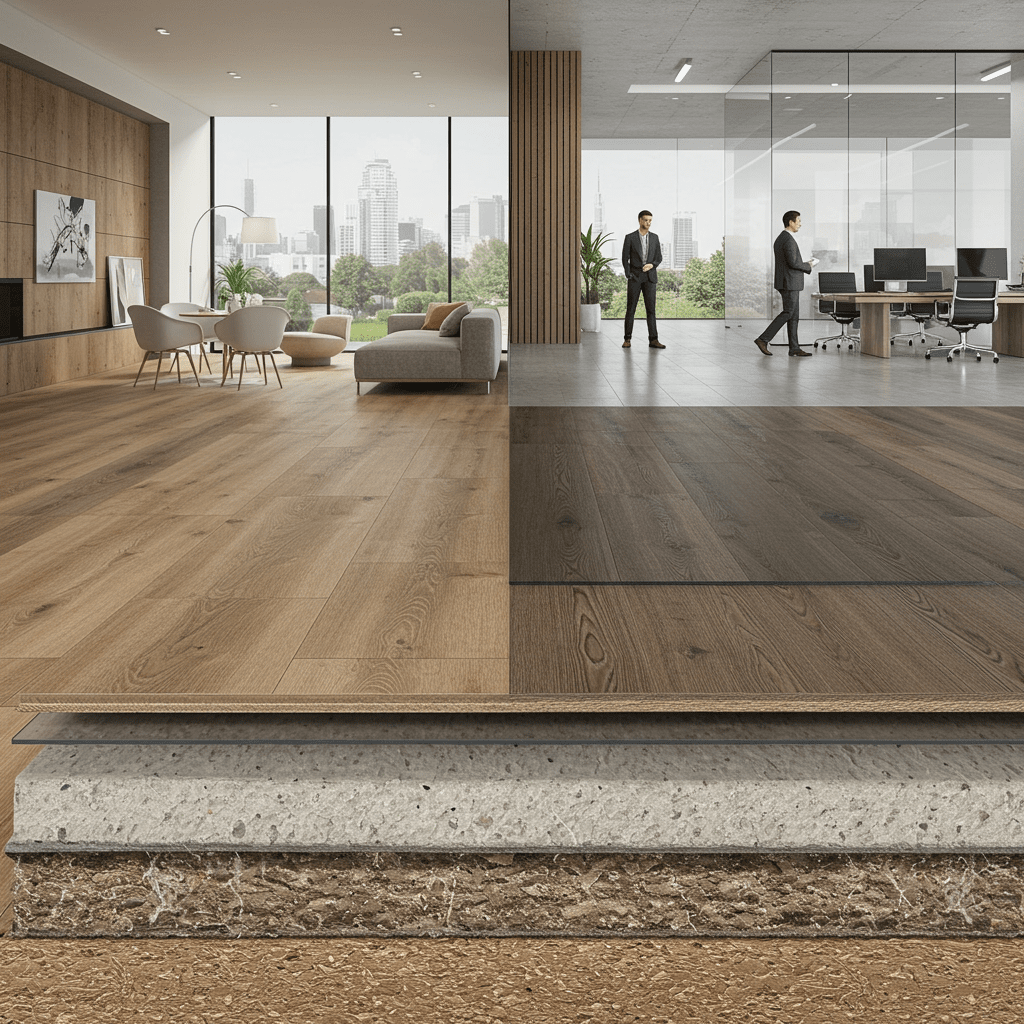
The wear layer is one of the most critical components of wear-resistant vinyl flooring, acting as a shield that guards against scratches, dents, and everyday wear and tear. In high-traffic areas, a thicker wear layer is vital to ensure long-lasting durability and maintain the floor’s appearance over time.
Residential use: A wear layer of 8 to 12 mil is generally sufficient for light to moderate foot traffic in homes.
Commercial use: Spaces with heavy traffic, like offices, retail stores, or hospitality venues, require wear layers starting at 20 mil or more for added resistance.
Opting for thicker wear layers also provides better protection, especially in spaces prone to spills, scratches, or frequent cleaning.
Commercial vs. Residential Ratings
Another critical factor is understanding the difference between flooring designed for commercial versus residential use.
Residential vinyl flooring: Ideal for areas like kitchens, hallways, and living rooms in homes, this flooring is durable enough to handle family life while offering a wide range of designs to suit your interiors.
Commercial vinyl flooring: Built with traffic-resistant surfaces and higher floor durability ratings, it’s engineered to withstand consistent use, heavy equipment, and additional cleaning requirements. Commercial-grade vinyl is the go-to choice for businesses with heavy foot traffic.
For areas that straddle both personal and professional use, like home offices or shared residential complexes, selecting vinyl with commercial-grade durability is a wise investment.
Impact Resistance and Durability
High-traffic zones are often subject to heavy impacts, whether it’s from dropped objects, moving furniture, or large equipment. This is where impact resistance and overall durability come into play.
Measuring Wear Layer Protection
A quick way to assess a vinyl floor’s ability to handle wear is by checking the thickness of its wear layer and whether it includes a protective floor coating. The thicker and more reinforced the wear layer, the better the floor will endure impact, scratches, and scuffs.
Understanding AC Ratings
When evaluating impact and durability, you may come across AC (Abrasion Criteria) ratings. These ratings are most commonly used with laminate flooring but can apply to some vinyl options as well.
They rank flooring from AC1 (light residential use) to AC5 (heavy commercial use) to provide insight into how well a flooring option will perform under specific conditions.
For vinyl flooring, selecting a product with a wear layer of at least 20 mil and a high AC rating ensures it will thrive even under demanding circumstances, offering maximum resilience in high-traffic spaces.
Top Vinyl Flooring Recommendations
Choosing the best vinyl flooring for high-traffic zones requires a balance between durability, style, and budget. Fortunately, there are several trusted brands that excel in delivering resilient flooring options built to withstand heavy use.
In this section, we’ll explore the best brands, compare top products for wear-resistant vinyl, and analyze the trade-offs between price and performance to help guide your decision.
Best Brands for High-Traffic Areas
When it comes to durable vinyl flooring, some brands consistently outperform others in terms of quality, performance, and longevity. Here are the top contenders:
Shaw: Known for high-quality luxury vinyl plank (LVP) flooring with advanced protective floor coatings that make their products resistant to scratches, stains, and heavy traffic.
COREtec: Offers premium traffic-resistant surfaces with a focus on water resistance and easy maintenance. Their luxury vinyl tile (LVT) and LVP collections are perfect for both residential and commercial use.
Mohawk: A cost-effective option that delivers exceptional durability and impressive designs, with commercial vinyl flooring solutions that resist wear and tear.
Armstrong: A reputable name in flooring, offering everything from classic sheet vinyl to premium luxury vinyl plank products designed for heavy-traffic areas.
Karndean: Excels in aesthetics and performance, with highly durable products that mimic natural materials like wood and stone while providing robust impact resistance.
Comparative Analysis of Top Vinyl Floors
When comparing high-traffic floor solutions, it’s essential to consider features like the wear layer, design variety, and ease of maintenance. Here’s how some of the top picks stack up:
| Brand | Wear Layer Thickness | Key Features | Ideal For |
|---|---|---|---|
| Shaw | 20-30 mil | Scratch-resistant; vibrant designs | Homes, restaurants, boutiques |
| COREtec | 12-30 mil | Waterproof core; durable planks | Bathrooms, commercial floors |
| Mohawk | 12-20 mil | Affordable; easy to clean | Busy family homes, home offices |
| Armstrong | 12-20 mil | Budget-friendly; water-resistant | Residential kitchens, small stores |
| Karndean | 20+ mil | Stunning natural designs; durable | Luxury homes, upscale commercial use |
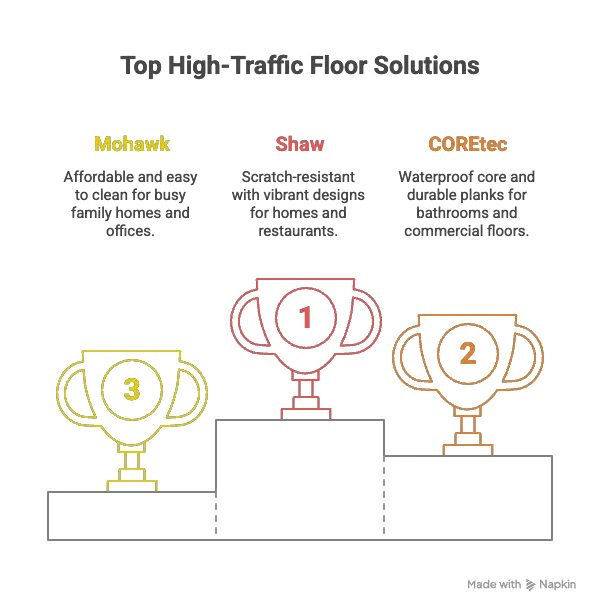
When choosing a product, look for a wear layer of 20 mil or thicker for the best protection in high-traffic areas, as well as products that feature protective coatings.
Price vs. Performance Breakdown
One of the biggest decisions when purchasing vinyl flooring is balancing price and performance. Many homeowners and business owners are tempted to choose cheaper options, but when it comes to traffic-resistant surfaces, investment in quality can pay off in the long term.
Here’s how to weigh price vs. performance:
Affordable Options:
Brands like Mohawk and Armstrong offer budget-friendly vinyl flooring with sufficient durability for light to moderate high-traffic zones. These are ideal if you’re on a strict budget or outfitting areas with lighter use, like guest rooms or small offices.
Mid-Range Options:
Flooring from brands like Shaw and COREtec balances cost and performance beautifully. With floor durability ratings suitable for both residential and commercial applications, mid-range vinyl works well in kitchens, hallways, and shared spaces.
Premium Options:
If you’re looking for unbeatable impact resistance, advanced designs, and luxury vinyl plank or tile that perfectly mimics natural materials, brands like Karndean are worth the investment. This category is ideal for upscale homes or high-end retail and office spaces.
Related Read: How To Get Yellow Stains Out Of Vinyl Flooring
Installation and Maintenance Tips
To maximize the longevity and performance of your durable vinyl flooring, proper installation and upkeep are essential. By following expert-approved techniques during installation and adopting smart care strategies, you can not only preserve the floor’s look and durability but also ensure your investment pays off in the long run.
Proper Installation Techniques
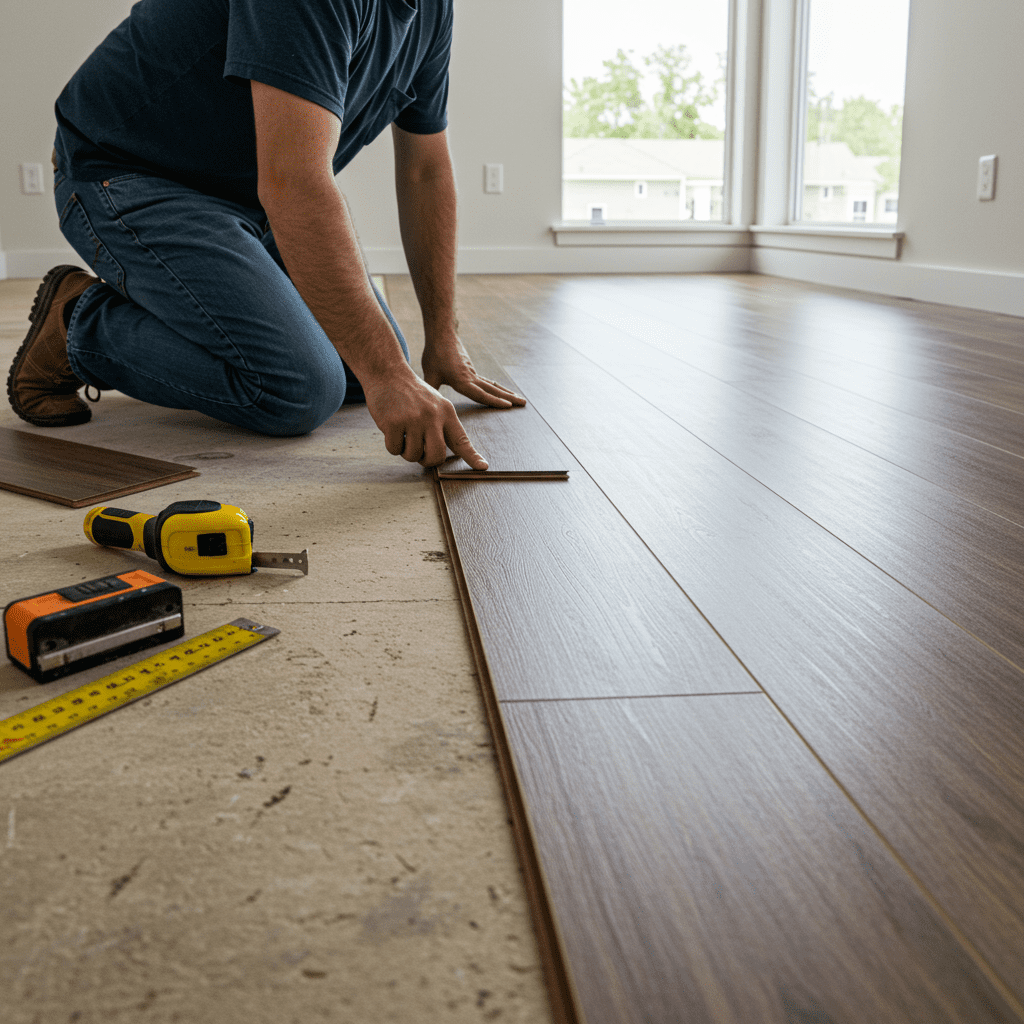
Getting the installation right is the foundation for maintaining durability, especially in high-traffic floor solutions. Here’s how to ensure a flawless setup:
Subfloor Preparation: Before laying the vinyl, make sure the subfloor is clean, dry, and level. Uneven surfaces can lead to bubbles or gaps in the flooring, reducing its durability over time.
Acclimate the Vinyl: Allow the vinyl planks, tiles, or sheet to acclimate to the room’s temperature for 24-48 hours before installation. This prevents expansion or contraction after placement.
Right Installation Method:
Click-and-Lock: Popular for luxury vinyl plank (LVP) and luxury vinyl tile (LVT), this method ensures a snug fit and easier removal if needed.
Glue-Down: Ideal for commercial vinyl flooring or areas with heavy traffic, this method provides a secure hold and reduces movement.
Loose Lay: Suitable for smaller spaces, this method relies on the vinyl’s weight and friction without adhesives but is less ideal for high-traffic areas.
Use Protective Underlayment: An underlayment can offer additional cushioning, sound absorption, and moisture resistance especially crucial in kitchens or bathrooms.
Cleaning and Care Strategies
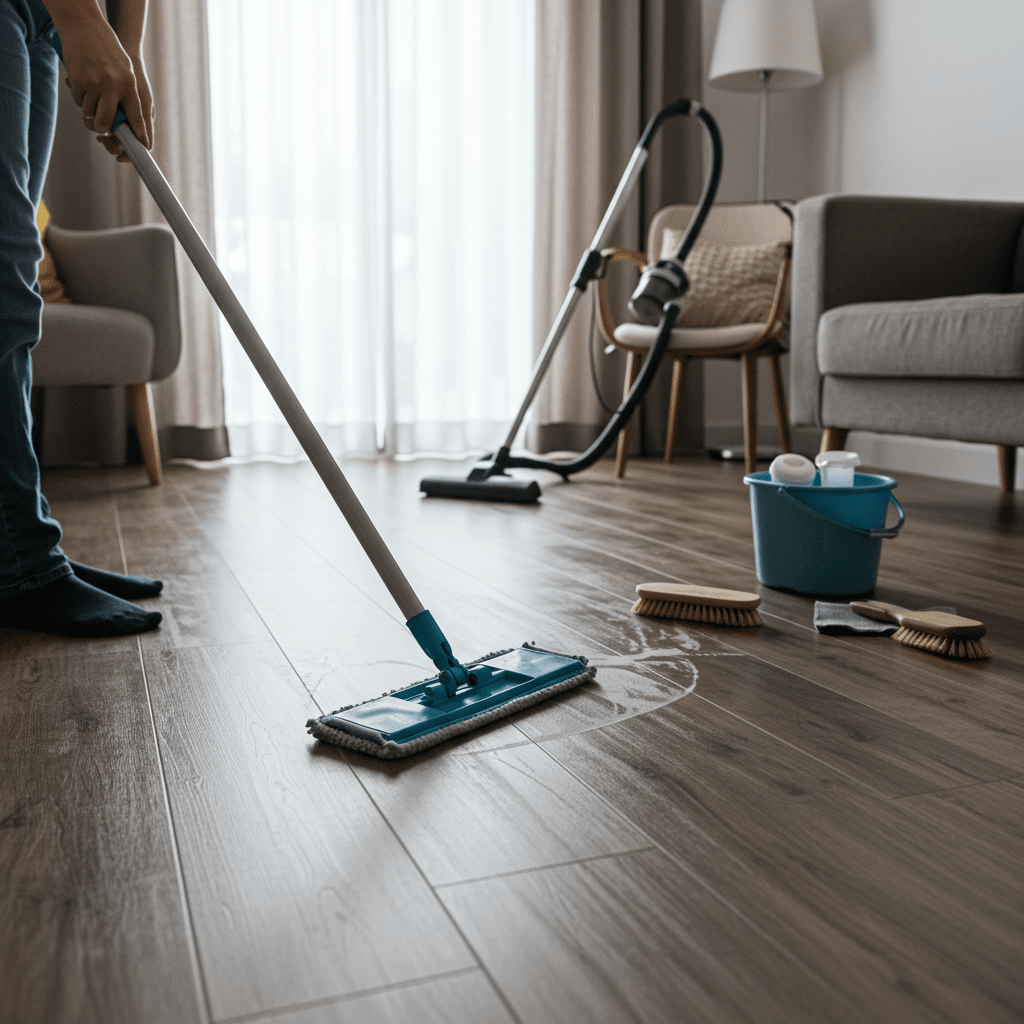
Keeping your wear-resistant vinyl in top-notch condition requires a simple yet consistent cleaning regimen. Regular maintenance helps retain its shine, reduces wear from debris and dirt, and extends its lifespan.
Daily Maintenance: Sweep or vacuum regularly to remove dirt and debris that can act like sandpaper and damage the protective floor coating over time. Use a setting suitable for hard floors to avoid scratching.
Mop Weekly: Wipe your vinyl flooring with a damp mop and a gentle cleaning solution designed for vinyl. Avoid harsh chemicals, abrasive pads, or scrubbing brushes, as these can degrade the surface.
Spot Clean Quickly: Spills and stains should be cleaned promptly to avoid staining or moisture seeping into seams (for products like sheet vinyl or improperly installed planks). A soft cloth and mild detergent usually do the trick.
Avoid Excessive Water: Vinyl is water-resistant but not invincible. Avoid using soaking wet mops or steam cleaners that can warp or damage the edges.
Protecting Your Investment
To truly make the most of your resilient flooring options and preserve their durability in heavy-use zones, prevention is key. Here’s how to protect your investment:
Use Floor Protectors: Place felt pads or rubber-backed furniture protectors under heavy furniture and table legs to prevent dents and scratches.
Entryway Mats: Use mats at entry points to trap dirt and debris before it makes its way onto your traffic-resistant surfaces. This helps reduce wear from abrasive particles.
Limit Exposure to Sunlight: Prolonged UV exposure can fade the colors of luxury vinyl plank or tile. Use blinds, curtains, or UV-resistant coatings to protect your floors in sunny areas.
Rotate Furniture Placement: If possible, shift heavy furniture periodically to prevent permanent impressions from forming in one spot.
Regular Inspections: Check for signs of wear, warping, or loose edges periodically, especially in high-traffic zones. Prompt repairs or replacements of damaged planks or tiles can help prevent further damage.
Related Read: Best Cleaner For Vinyl Floors: Factors to Consider
Pros and Cons of Vinyl in High-Traffic Zones
When choosing the best flooring for high-traffic areas, it’s crucial to evaluate all aspects of your options. Vinyl flooring has grown in popularity due to its ability to withstand heavy use without sacrificing style, but like any material, it comes with its own set of advantages and limitations.
Below, we’ll explore the key advantages, potential drawbacks, and how vinyl compares to other popular flooring options.
Advantages of Vinyl Flooring
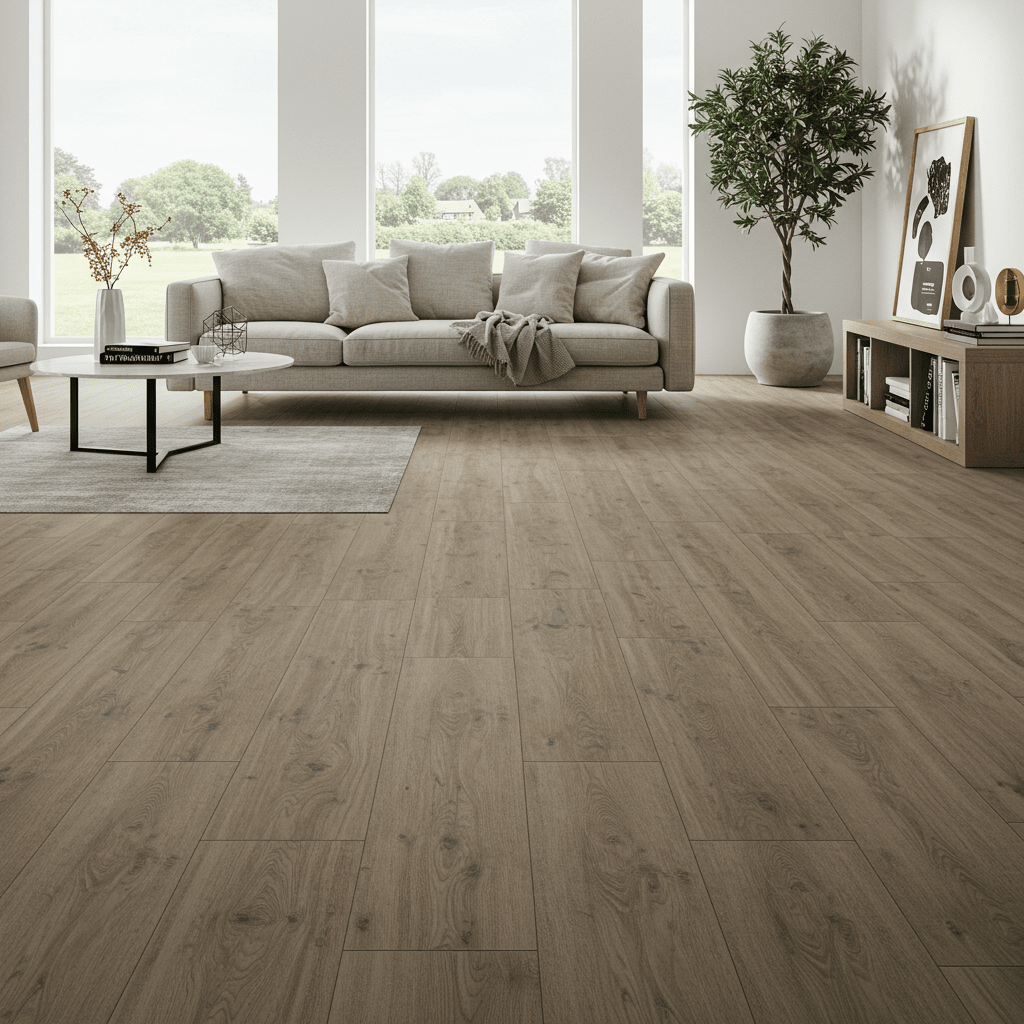
Vinyl offers a range of benefits that make it a top choice for high-traffic zones in both residential and commercial settings.
Durability and Resilience: Durable vinyl flooring is designed to handle heavy foot traffic, making it ideal for busy kitchens, hallways, and workplaces. Its protective floor coatings and wear-resistant vinyl layers ensure long-term performance.
Water Resistance: Most vinyl flooring, including luxury vinyl plank (LVP) and sheet vinyl, is water-resistant or even waterproof. This makes it perfect for areas prone to spills or moisture, like kitchens, bathrooms, and entryways.
Affordable Pricing: Compared to other high-traffic floor solutions, vinyl is significantly more cost-effective while still offering style and reliability.
Easy Maintenance: Vinyl floor maintenance is simple and hassle-free, requiring only regular sweeping and occasional mopping to keep it looking pristine.
Versatile Design Options: Vinyl can mimic natural materials such as hardwood, stone, or ceramic at a fraction of the cost, making it a stylish and budget-friendly option.
Comfort Underfoot: Vinyl provides a softer and warmer feel compared to harder materials like tile, making it more comfortable for prolonged standing or walking.
Ease of Installation: With options like click-and-lock systems, vinyl installation is quick and DIY-friendly for homeowners.
Potential Limitations
While vinyl flooring excels in many areas, it’s not without its drawbacks. Here are some potential limitations to consider:
Susceptibility to Damage: Despite being traffic-resistant, vinyl can still be vulnerable to sharp objects, dragging furniture, or heavy impacts, which may leave dents or cuts.
Fading from UV Exposure: Prolonged exposure to sunlight may cause discoloration over time, particularly for spaces with large windows or minimal shading.
Seam Vulnerability: For sheet vinyl, poorly installed seams can allow moisture to seep in, potentially leading to warping or damage.
Not Fully Eco-Friendly: While some brands are improving sustainability, vinyl flooring is primarily made from PVC (a plastic material), which isn’t biodegradable. Recycling options are also limited.
Repair Challenges: Unlike hardwood, which can be sanded and refinished, repairing damaged vinyl often requires replacing individual planks or tiles entirely.
Price Variation by Quality: While affordable options exist, premium luxury vinyl plank or tile products with thick wear layers and realistic designs can approach the cost of mid-range hardwood or laminate.
Comparison with Other Flooring Options
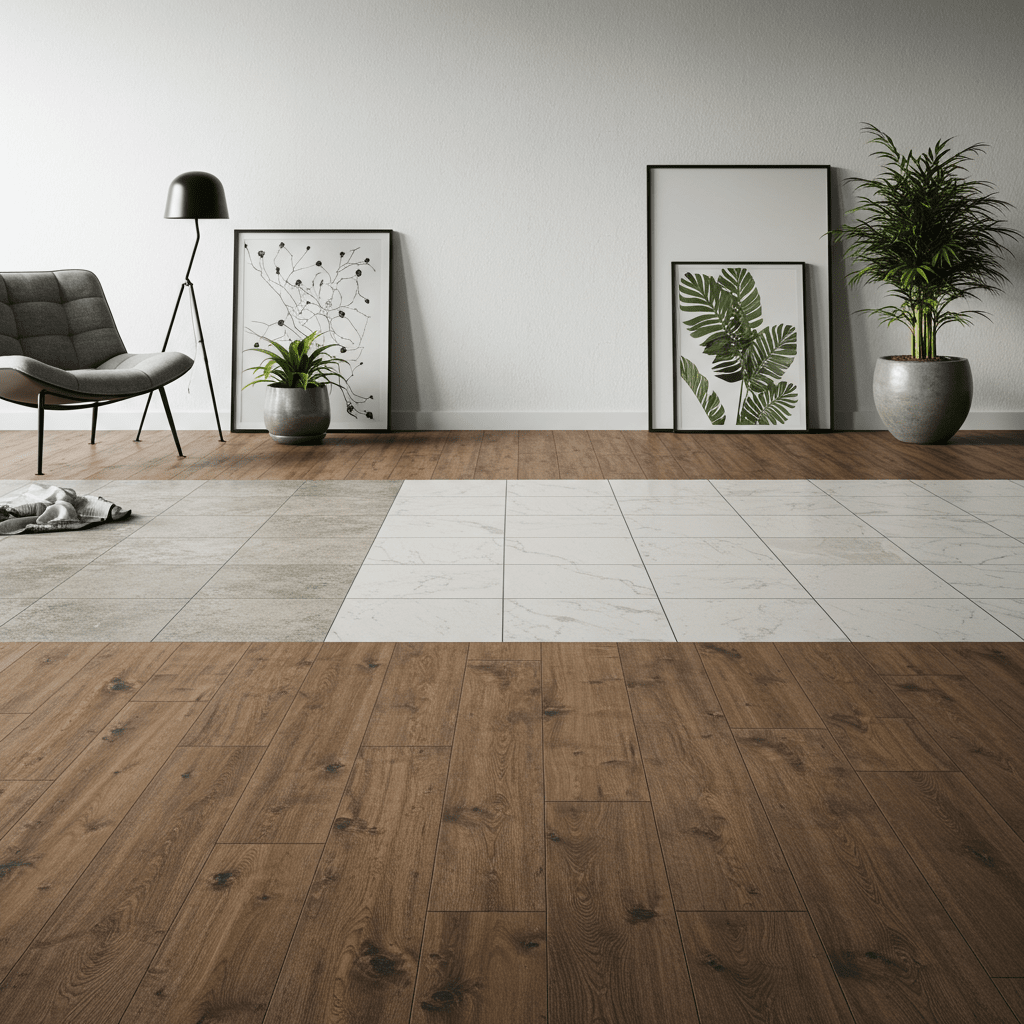
To give you a better understanding of vinyl’s standing, here’s how it compares to other popular flooring materials commonly used in high-traffic zones:
| Flooring Type | Key Advantages | Key Limitations | Best For |
|---|---|---|---|
| Vinyl Flooring | Durable, water-resistant, affordable, easy to maintain | Can dent or fade, limited eco-friendliness | Kitchens, bathrooms, commercial spaces |
| Laminate | Affordable, scratch-resistant, realistic wood designs | Less water-resistant, harder underfoot | Living rooms, home offices |
| Hardwood | Timeless aesthetic, can be sanded/refinished | Expensive, prone to scratching, water damage | Bedrooms, formal living spaces |
| Tile (Ceramic/Porcelain) | Durable, water- and heat-resistant, low maintenance | Hard and cold underfoot, grout can stain | Bathrooms, laundry rooms |
| Carpet | Soft underfoot, good for sound absorption | Hard to clean, not suitable for wet or high-traffic areas | Bedrooms, low-traffic areas |
| Engineered Wood | Combines hardwood look with better moisture resistance | Still vulnerable to scratches, more costly than vinyl | Living spaces, formal areas |
Conclusion
Selecting the perfect vinyl flooring for high-traffic areas doesn’t have to be overwhelming. With a clear understanding of your unique needs and priorities whether it’s durability, water resistance, aesthetics, or ease of maintenance you can make an informed decision that fits both your budget and lifestyle.
By focusing on features such as wear-resistant vinyl, protective floor coatings, and floor durability ratings, you ensure your investment pays off in the form of reliable, stylish, and hard-wearing floors.
With options that range from luxury vinyl plank (LVP) to sheet vinyl, the choices are versatile enough to suit both residential and commercial spaces.
Whether you’re upgrading your home or outfitting a busy workspace, vinyl flooring strikes the perfect balance between function and beauty.
When properly installed and maintained, it will stand the test of time ready to handle everything from heavy foot traffic to life’s unexpected moments.
Ready to transform your space? Choose durable vinyl flooring that’s built to last and enjoy a floor that works as hard as you do.
FAQs
How long do vinyl floors last in high-traffic areas?
Typically 10-20 years with proper maintenance.
Are vinyl floors waterproof?
Most luxury vinyl options are water-resistant or waterproof.
Can vinyl flooring be installed over existing floors?
Yes, in most cases, creating a cost-effective renovation option.
How do I choose the right wear layer?
For high-traffic areas, select a wear layer of 20 mil or higher.
Are vinyl floors eco-friendly?
Modern vinyl floors are increasingly made with sustainable materials.

